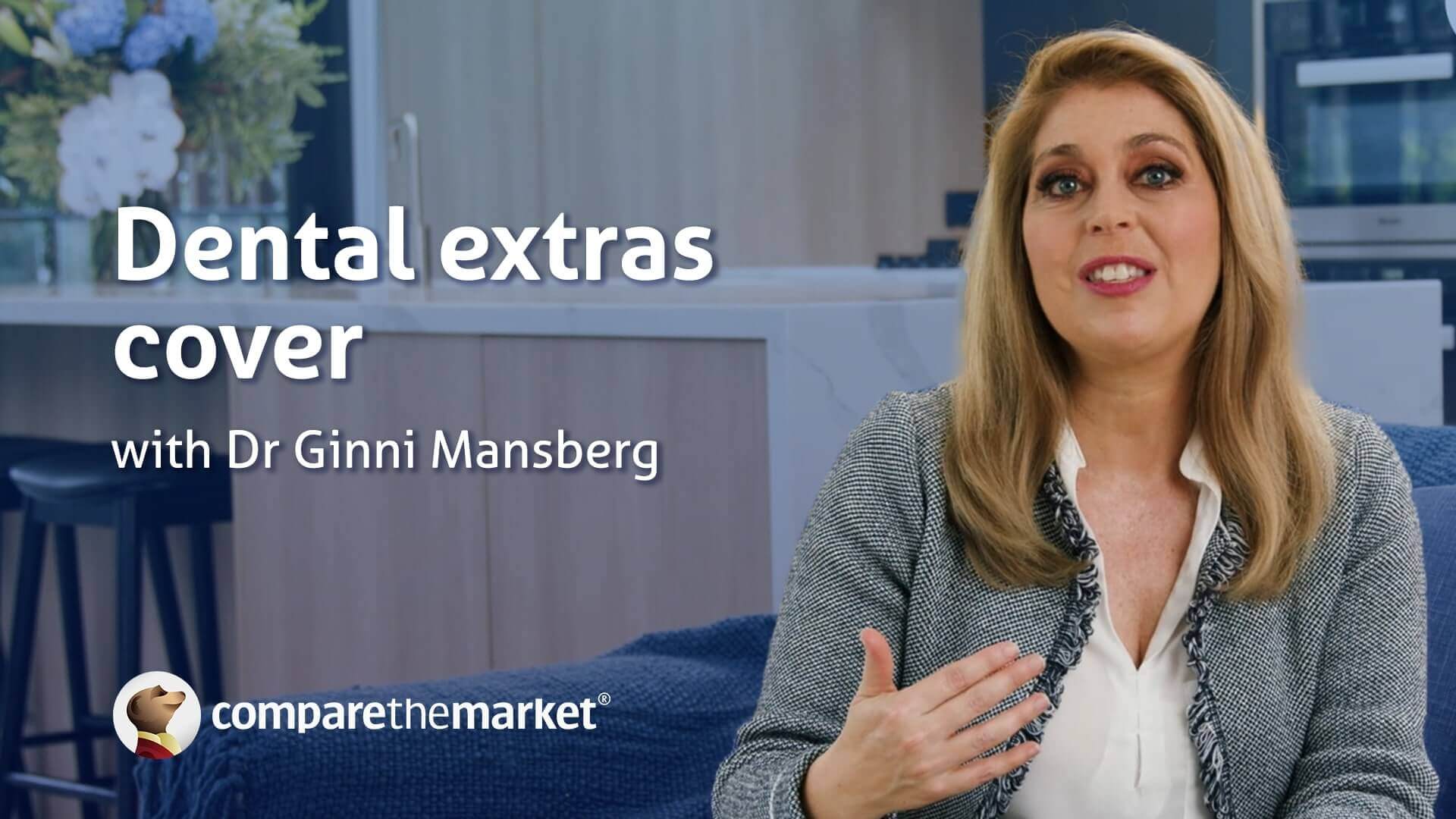Home / Compare Health Insurance / Health insurance for den…
Health insurance for dental in Australia
Looking for cover for your dental needs? We’re here to help! Call today to chat to one of our health insurance experts.
- Australian owned and operated call centre
- Speak to an expert right away
- A quick call could save weeks of research




Key takeaways
- While there’s no standalone product on the market called ‘dental insurance’, you can get cover for dental services on an extras health insurance policy.
- The dental benefits offered on an extras health insurance policy are typically categorised into four groups: general dental, major dental, orthodontic and endodontic.
- The waiting periods you’ll have to serve before claiming will vary between dental services, with more expensive services like orthodontics coming with longer waiting periods, while the waiting period for a scale and clean could be as low as two months.
Dental cover explained



Hi, it’s Dr. Ginni Mansberg, GP and health commentator in the media.Hi, it’s Dr. Ginni Mansberg, GP and health commentator in the media.
I’m here to talk about your teeth. We all know that we should be flossing our teeth at least once a day and brushing them twice.
But a six-monthly visit to the dentist is something that we Aussies are really bad at doing, and the cost of skipping those visits can be really high.
Australia is lucky enough to have an excellent medical system that helps you access health care for many medical problems.
But that system won’t cover everything, especially a trip to the dentist.
If you need support for getting access to services, including dental checkups, braces and orthodontics, fillings, crowns and bridges or removal of wisdom teeth.
Private health insurance might be a good choice for you. Chat to the experts about which one suits your needs.
Expert tips for choosing the right dental cover for you
Our health insurance expert, Steven Spicer, has put together some tips on how to find the right dental cover for you.

Look out for your health fund’s agreement dentists.
With dental cover, you’re free to visit any qualified registered dentist of your choice. However, it’s worth looking into whether your health fund has any preferred dentists that they have agreements with. These agreements usually provide members with clear pricing terms, reduced costs and, in some cases, even gap-free treatment.
Decide if you want dollar or percentage limits.
The amount you get back on your dental work can vary from fund to fund and policy to policy. Some policies provide percentage-back refunds for your dental bills, up to an annual limit, compared to others that provide fixed-dollar benefits. Each limit type has its pros and cons, so the best choice depends on your needs and preferences. If your dentist is more expensive than others, the percentage option may be more in your favour. If you mostly receive low-cost treatments, a dollar limit may be a better option.
Understand all the limits that apply.
When you take out an extras policy for dental treatment, make sure you’re aware of the different claim limits that apply. Not only will you have an annual limit (which limits how much you can claim per year), you may also be subject to group limits, sub-limits, service limits and more. While a policy with more limits may be cheaper, it will also restrict how you can use your new cover.
Why take out dental cover?
Health insurance with dental coverage plays an important role in looking after your oral health. Since Medicare typically doesn’t pay for dental treatment, you’ll need to take out an extras policy with inclusions that cover your dental treatment or pay the full cost out of pocket. Here’s why dental cover can be beneficial:
- On average, Australians spend around $259 on dental fees each year.1 Between the cost of check-ups, cleanings, braces and more, the cost of dental care can really add up. Dental cover can pay some or all of the cost of your regular care up to the annual limit and give you the peace of mind that you won’t have to break the bank if the unexpected arises.
- Depending on your policy and inclusions, you can be covered for a wide range of dental services including new crowns, tooth removal and even implants to replace missing teeth.
- Just because Medicare doesn’t cover out-of-hospital dental care as standard, doesn’t mean it’s not important. In fact, poor oral health has been linked to several other health issues including heart disease and respiratory illnesses.2
Choosing cover for dental
Dental cover is a common benefit included on extras health insurance policies. With so many policies offering cover for dental services, it can be hard to decide the right one for you. Here are a few things you should consider when purchasing dental cover:
- Limits. When you claim on your extras insurance policy, there are limits on the total amount you can claim. These limits vary between policies, so it’s important that you choose a policy with limits that suit your insurance needs.
- Level of cover. Extras health insurance policies are typically divided into levels based on their cost and the services they cover. The right level of cover for you will depend on personal circumstances like your budget, healthcare needs and lifestyle.
- Life stage. The right cover for you will also depend on your stage of life. For example, you may want cover for orthodontics if you have young children who might need braces, or you may be an older Australian who wants cover for dentures, implants or tooth removal.
- Who needs cover. If you’re in a couple and/or have children, you’ll want to look into a policy that takes care of all your loved ones. Depending on your situation, you can look into couple, single parent or family policies to meet your health needs.
How dental cover works
Can I get health insurance for only dental treatment?

There isn’t a specific product called ‘dental insurance’ or ‘dental health insurance’, so you’re unlikely to find a standalone policy in Australia that only provides cover for dental treatment. Most dental services are covered by extras policies, which may also include cover for other services like physiotherapy, optical and chiropractic.
Private hospital cover won’t include most dental treatments, as they take place outside of hospital. However, some private hospital policies can help pay towards in-hospital dental treatment and operations like wisdom tooth extraction if, for example, surgical extraction is required. Not all wisdom tooth extractions are performed in-hospital, so hospital cover will only help with very specific procedures, and the type of cover you need will depend on your individual circumstances.
With a combined hospital and extras health insurance policy, you could be covered for dental treatment both in and out of hospital. For example, if you need complex dental work that requires surgery in a hospital and follow-up appointments in the dentist’s office. In this scenario, an extras policy with the appropriate level of dental cover may be beneficial for your in-hospital procedure. For example, if you need to have your wisdom teeth removed in hospital, the rebate for the extractions themselves will be determined by your extras policy.
Waiting periods for dental cover
The length of time you’ll have to wait before being able to claim on dental benefits will vary depending on your health fund, your policy and the treatment you’re claiming for.
Unlike with hospital cover, waiting periods for extras cover aren’t set by the government. Each health fund sets its own waiting periods for each of their extras policies, so there’s more variety between policies than there is with hospital cover. With that in mind, below is how long typical waiting periods might be for dental cover:3
| 2 months | 12 months | 12+ months |
|---|---|---|
| General dental will typically have a two-month waiting period, which means you may have to wait this long after taking out your policy if you want your health insurance to help pay for your clean, scales or fillings. | If you want to get a major dental procedure done (e.g. crowns or bridges), you’ll generally have a 12-month waiting period before you can claim for treatments on your health insurance policy. | Some higher-cost procedures like orthodontics (e.g. braces) may have a 12-month wait or can even stretch to 2 or 3 years. |
It’s essential to take out cover well in advance so that you’ve served your waiting periods by the time you start experiencing any issues. When comparing and purchasing extras health insurance, make sure you confirm your applicable waiting periods.
Do I have to re-serve my dental waiting period if I change health funds?
If you’re moving health funds and you’ve already served your dental waiting period, you most likely won’t have to wait again for the same treatments and services provided you switch to the same or lower level of cover.
However, if you want to claim a treatment or service you weren’t previously covered for – or you want to enjoy higher claiming limits – you’ll have to serve your waiting period from the start for the additional benefits.
Out of pocket dental expenses
In most instances, you will have some out-of-pocket expenses. However, some funds offer gap-free dental when you see a preferred provider. This refers to a dentist who has agreed to charge no more than your health fund will cover. As such, it’s worth checking your health fund’s website to see if they list any gap-free dentists.
Dental cover for kids
 Dental care for kids can get expensive; between braces, wisdom teeth, mouth guards and chipped teeth, you might end up taking your young ones to the dentist more than you think. Luckily, if you’re already on a couples or family policy, you may be able to add your child to it at no extra cost (this will depend on your health fund).
Dental care for kids can get expensive; between braces, wisdom teeth, mouth guards and chipped teeth, you might end up taking your young ones to the dentist more than you think. Luckily, if you’re already on a couples or family policy, you may be able to add your child to it at no extra cost (this will depend on your health fund).
You’ll want to make sure your policy includes appropriate coverage for your child’s needs and review your cover often. There can be waiting periods for any additional coverage or person you add, so change early to serve your waiting periods in time.
There’s also the Child Dental Benefits Schedule (CDBS) scheme to consider, which is a service run by the Australian Government that provides eligible children up to $1,132 towards dental treatment over two calendar years. The eligibility criteria is based on families who are receiving selected government payments through Centrelink. The CDBS can cover dental services including:
- Dental check-ups
- Cleanings
- Fillings
- X-rays
- Root canal treatment
- Tooth extractions.
The CDBS won’t cover orthodontic, cosmetic work or any hospital treatments.
Read more about health insurance for children and dependents here.
What dental cover includes
What are the different levels of cover?
If you require dental treatment, private health insurance can provide varying levels of coverage to match your needs and contribute to the cost of dental treatments.
Extras policies typically include a range of services that can be categorised into four main groups: general, major dental, endodontic and orthodontics. Your level of cover and your insurer will determine what exactly is included in your policy.
General dental
Usually helps pay for preventative treatments like:
- Oral exams (dental check-ups)
- Scale and cleans
- Simple fillings
- Fluoride treatments
- X-rays
- Tooth extractions (can be general dental or major dental, depending on the item number your dentist uses and the policy you have)
Major dental
Generally, major dental covers more complex treatments, such as:
- Tooth extraction (can be general dental or major dental, depending on the item number your dentist uses and the policy you’re on).
- Wisdom teeth removal (can be general dental or major dental, depending on the item number your dentist uses and the policy you’re on). This can also be performed in a hospital and so may require private hospital insurance.
- Complex fillings for the treatment of tooth decay and damage.
- Crowns and bridges (dental implants for a single damaged tooth or multiple teeth).
- Veneers (thin implants that cover the front of the tooth for generally cosmetic reasons).
- Dentures.
Endodontic
Treatment for the soft tissue of teeth including:
- Root canal therapy, which is an endodontic procedure to dig into a cracked tooth and extract inflamed tissue.
- Periodontics, which is the treatment of gum tissue diseases like gingivitis, infection and inflammation.
Orthodontic
The process of correcting teeth that aren’t in the right position, usually with braces or Invisalign. Orthodontic is usually a separate category to other dental inclusions. Orthodontic treatment is typically only included on higher levels of cover and comes with longer waiting periods.
Does health insurance cover visits to any dentist?
Yes, health insurance contributes towards the cost of dental work with any qualified registered dentist. However, some health funds offer additional benefits such as no gap payment if you visit dental clinics or healthcare specialists they’ve partnered with or a health fund-owned dental clinic.
You should also check whether your fund accepts claims via HICAPS. This system enables the dentist to process your health fund claim on the spot rather than you paying the bill upfront, then claiming back the benefit from the fund.
Does health insurance cover the cost of dental implants?
Yes, some extras health insurance policies can pay towards the cost of a variety of dental implants, although you will likely still have some out-of-pocket costs. Dental implants are usually covered by the major dental category, so you’ll need to have this as part of your policy to receive benefits.
As a more expensive service, you’ll also typically have to serve a longer waiting period before you can claim for dental implants.
Does extras health insurance cover cosmetic dental surgery?
Usually, health insurance will only cover procedures if they’re considered medically necessary. Some extras policies may pay a benefit towards eligible cosmetic treatment, such as teeth whitening; however, your chances of your claim being successful will greatly improve if the treatment also serves a medical purpose.
Treatments that serve a purely aesthetic purpose are unlikely to be covered by your health fund. However, many procedures that can help improve your appearance may also be deemed medically necessary (e.g. implants or veneers), and therefore can be potentially covered.
Under the right circumstances, extras policies can potentially cover:
- Crowns (custom-made tooth cap)
- Implants (replaces lost or missing teeth)
- Veneers (bonding porcelain or resin)
- Teeth whitening
- Orthodontics (e.g. braces, dental aligners).
Your cover will vary depending on your health fund and policy, as well as on the specific circumstances around why you’re getting the treatment. The best way to find out for sure is to check your policy brochure or call up your insurer to determine your eligibility.
Does health insurance cover Invisalign?
Yes, some extras health insurance policies can cover Invisalign treatment (clear aligners for teeth) under orthodontics, as it’s treated similarly to traditional braces. However, not all policies cover Invisalign treatment; even if they do, you’ll have to serve the waiting period for orthodontics.
If you’re taking out health insurance just to get Invisalign treatment, make sure your policy covers it and you’re aware of any limits and waiting periods.
Dental cover limits
Your limits will depend on your policy; some health insurance policies offer higher dental claim limits than others. That’s why it’s so important to compare policies and look for those with generous claim limits on the services you need!
With extras policies, your dental cover may be subject to:
- Annual limits (e.g. $700 per year on dental)
- Sub-limits (e.g. maximum of $300 out of the $700 on major dental)
- Group limit with other ancillary services (e.g. a group limit to spend across all general dental, major dental and endodontic services)
- Lifetime limits (e.g. $2,900 to spend on orthodontics in each person’s lifetime)
- Service limits (e.g. periodic and oral exam payable once every six months)
- Per person limits (e.g. $500 annual limit per person).
These limits mean your health fund will only cover up to the stated limit, and you’ll have to contribute the rest. Benefits can be paid as a set dollar amount or a percentage of the total cost.
Meet our health insurance expert, Steven Spicer
As the Executive General Manager of Health, Life and Energy, Steven Spicer is a strong believer in the benefits of private cover and knows just how valuable the peace of mind that comes with cover can be. He is passionate about demystifying the health insurance industry and advocates for the benefits of comparison when it comes to saving money on your premiums.
Want to know more about dental cover?
1 Australian Institute of Health and Welfare, Oral health and dental care in Australia. Updated May 2025.
2 Better Health Victoria, Teeth and mouth care. Accessed May 2025.
3 The Commonwealth Ombudsman – Waiting periods for private health insurance. Accessed May 2025.